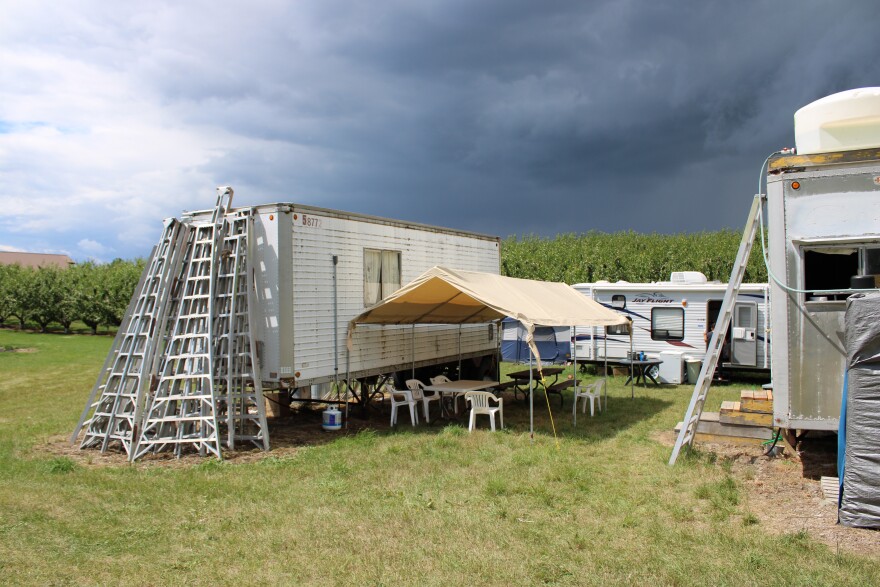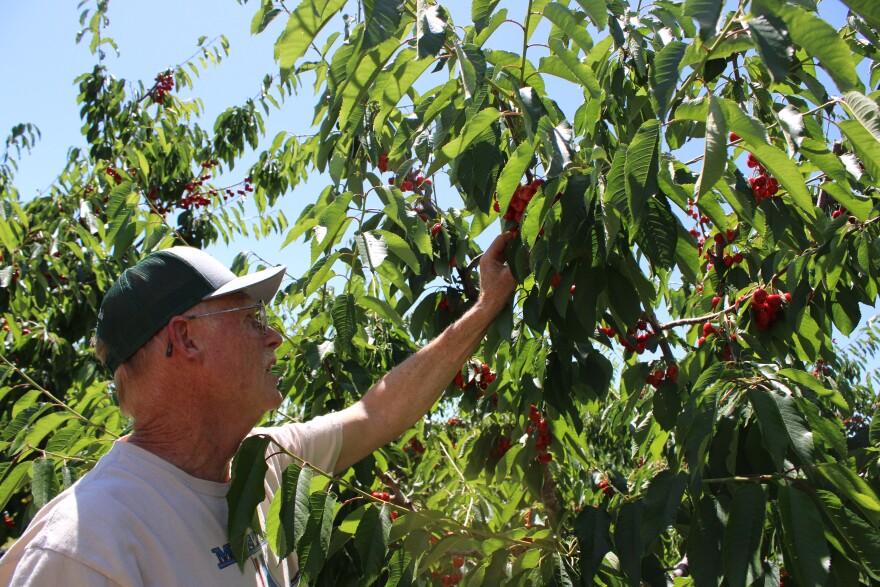In early July, a transformation takes place on the eastern shorelines of Flathead Lake. As the Mission Mountains loom in the background, endless groves of trees begin to display little red fruit. The cherries glint like crimson jewels in the mid-day sun.
For over 15 years, Maria Gomez has worked in these orchards seasonally. She and her husband travel from Washington to Montana to harvest cherries for about two weeks in July. They get paid about 25 cents per pound.
Gomez likes working here. She says she comes for the benefits.
“Because it’s like a vacation,” Gomez said in Spanish. “There aren’t places where you can spend time outdoors like here. Here, they can go to the lake and do things like that.”
There are opportunities for her children, and medical services offered to agricultural workers. Many of her friends and family have done this work, too. But now, she says things have changed.
“Things aren’t like they used to be,” Gomez said in Spanish. “Maybe it’s because of what’s going on right now, but things aren’t the same.”
Montana’s Flathead Valley cherry industry relies heavily on migrant labor. President Donald Trump’s recent immigration policies threw the industry into a new level of uncertainty.
This year, workers hesitated to cross state lines. Immigration and Customs Enforcement ramped up arrests following an Executive Order from President Trump in January. Montana’s Attorney General Austin Knudsen also signed an agreement in February to offer the state Highway Patrol to aid in immigration enforcement.
Documented or otherwise, the fear of the unknown, of ICE arrests and of what may happen if they were detained kept many from traveling to places they felt more vulnerable.
This hesitation from the orchard workforce put growers in a precarious position. Without the laborers, millions of pounds of fruit would be in jeopardy of going unpicked. The result was a near-miss labor shortage for the Flathead Valley.
That has growers concerned for the future.

In early July, grower Bruce Johnson’s trees were bursting with fruit. There are about 300 acres of cherries that need to be picked in the Flathead. Many growers have relationships with workers who return year after year.
Johnson is a board member for the Flathead Cherry Growers Association. He explains this year was different.
“They generally call us, say, we want to know what the fruit's like, when can I come, because they really want to come,” he said. “It was just kind of getting the word around that none of us were hearing from them. So, that's when we started worrying.”
In March, immigration enforcement officers arrested 17 people in Bigfork they said were undocumented. That’s about 15 minutes north of Johnson’s orchard. By July 3, Johnson says many growers had only heard from about half of their workers than normal.
Over the next three weeks, things changed.
Various factors like hail, wind, and market volatility reduced the amount of cherries that needed harvesting. At the same time, enough families decided to make the trip to Montana that a looming workforce crisis was averted.
But migrant workers who spoke to MTPR said they knew many people too afraid to leave their communities in Washington. Some workers who came said they are scared, but need the work to support their families.
Brian Campbell is a local field representative for Monson Fruit. The Washington-based company packs and distributes most Flathead cherries that go to market.
Campbell says these workers are skilled and vital to the cherry industry’s success.
“If you scare them to the point where they're not going to come and work, then the cherries are going to rot on the tree,” he said.

Much of Montana’s agricultural industry has a strong relationship with seasonal and migrant laborers. Over 3,000 foreign agricultural workers worked in Montana during the 2024 fiscal year. About 400 more come to work in orchards each summer.
Montana’s Department of Labor and Industry Commissioner Sarah Swanson says the agency would help growers find labor in the future if needed.
"There's lots of ways we could help them build kind of a response effort to projected workforce shortages in a short turnaround,” Swanson said.
But Campbell says trying to find 400 replacement workers to come for two weeks skilled in picking cherries would be an “exercise in futility.”
That’s why many workers did show up. Alma has been coming to these orchards since she was a girl. She asked to be identified by only her first name out of concern of being targeted by ICE.
“Before, people came here and just looked for work,” she said in Spanish. “Now the growers are looking for workers.”
She says she loves coming to western Montana and enjoys working for the people here. Alma and other workers told MTPR they feel respected and safe. But, Alma says she doesn’t know what she can do if arrests of migrant workers continue.
“If things get more difficult, as I see there are less people working here, I imagine it will get to the point where there won’t be cherries anymore,” Alma said in Spanish.
Montana Public Radio is a public service of the University of Montana. State government coverage is funded in part through a grant from the Corporation for Public Broadcasting.


